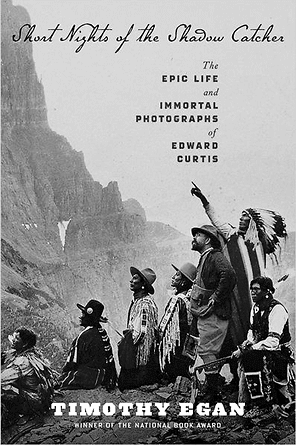
He lost some of his vigor, but never the will to finish the project, which took him 30 years.Įgan is particularly good at fleshing out lesser-known aspects of Curtis’s life: his dogged efforts to uncover the real story of the Little Bighorn, his re-creation of Pacific Indian life in his 1914 film “In the Land of the Head-Hunters,’’ his Hollywood hackwork for Cecil B. Eventually, Curtis’s long-suffering wife, Clara, sued for divorce and was awarded his studio. Pierpont Morgan, “a crow-eyed collector of art, railroads, and women,’’ who agreed to fund the fieldwork, but not the photographer. In 1906, as his grand plan was running out of money, Curtis struck a deal with J. Those who didn’t try for the highest peak were doomed to the foothills.”

Curtis courted the Smithsonian, and in a typical rhetorical flourish, Egan writes: “And just what made a dropout from a one-room schoolhouse think he could get the nation’s top ethnologists to back his project? Balls. Teddy Roosevelt contributed a foreword for the project, but no money. He had to make time to sell his “Big Idea” to potential backers. Curtis worked frenetic “sixteen-hour days, seven days a week,” neglecting his wife and family, incurring major debt. He vowed to publish 20 volumes documenting the 80 remaining North American tribes in 1,500 photographs with accompanying ethnographic text - within five years.

But it’s clear his sympathies lie with the audacious creator of the arresting images of Chief Joseph of the Nez Perce, the aging Apache Geronimo, Navajo horsemen diminutive against the towering cliffs of the Canyon de Chelly, Hopi maidens with their hair in squash blossom swirls, and some 40,000 more that are his legacy.Ĭurtis’s “impossibly grandiose idea’’ began to take shape.

Winner of a National Book Award for “The Worst Hard Time,’’ his book about the Depression-era Dust Bowl, Egan here offers a carefully researched portrait of the man the Indians called the “Shadow Catcher.” Evenhanded and free of conjecture, Egan’s narrative traces the career of the 6-foot-2 mountaineer with the Vandyke beard who was born in 1868 and scrabbled from poverty to prominence in Seattle with his camera, along the way rubbing elbows with scientists, presidents, and titans of commerce, before fading into near oblivion before his death in 1952.Įgan takes a neutral stance toward Curtis’s sometime manipulations of his subjects’ costumes and rituals. Timothy Egan brings liveliness and a wealth of detail to his biography of the legendary American photographer Edward Sheriff Curtis.


 0 kommentar(er)
0 kommentar(er)
